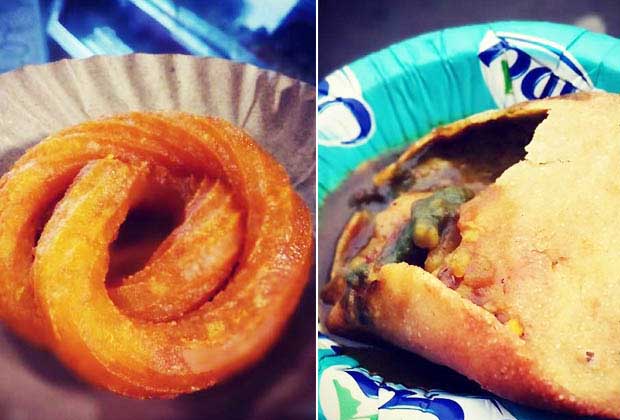Gwalior Food Guide: Where And What To Eat
- By Amit PatnaikLoading...
- | 25 April 2016 11:28 AM GMT
 X
X
 Paneer jalebi (left) & Jodhpuri kachori. Photos: Amit Patnaik
Paneer jalebi (left) & Jodhpuri kachori. Photos: Amit Patnaik
Just two hours away from Agra, and on the Bhopal-Shatabdi railway route, Gwalior’s towering fort and imperial palace conspicuously manage to slip under the Golden Triangle tourist radar. You shouldn't mind though, you can indulge in the city's historical and culinary charms without the crowds and tourist traps. Whatever brings you to Gwalior, we've got you covered on what you should eat.
Breakfast at SS Kachoriwala, Bahadoora ke Ladoo & Aggarwal Poha Bhandaar
If two establishments were to represent the food of Gwalior, they would be the iconic SS Kachoriwala and Bahadoora ke Ladoo. A stone's throw from each other, land on Nayi Sadak as soon as you can in the morning and head straight to SS, to get your fix of fresh-off-the-kadhai kachoris. These sell out fast and late risers might have to wait for hours till the next batch.
Resist the urge to go for their jalebis and walk down instead to Bahadoora. It’s easy to miss the decrepit verandah and obscure board; however the unmistakable aroma of boondi being fried in desi ghee will lead your nose right to it. Enjoy the guilty pleasure of dunking a freshly-shaped ladoo, redolent of desi ghee even as it falls apart into tiny pearls, much like our former Prime Minister, Shri Atal Behari Vajpayee, who is said to have adored the ladoos.
Keep walking down Nayi Sadak and towards Daal Bazaar, and be on look out for a large tawa brimming with golden poha. Aggarwal Poha Bhandaar is a name synonymous with poha in Gwalior, with many a shop contending to be the real McCoy. I’ll put my money on the plate of freshly-steamed, chaat-like, multi-textural poha here. This rare combination of health and taste, a remnant of the city’s Maratha heritage, is much closer to the mélange of Indori poha than what you would find in Maharashtra.
 Lambi paanipuri is a Gwalior speciality. Photo: Amit Patnaik
Lambi paanipuri is a Gwalior speciality. Photo: Amit Patnaik
Chaat around town: Lambi Pani Poori and Karela Chaat
Perhaps, one of the true pan-India chaats, the panipuri goes by many names and variations in the country; from gupchup and phuchka in the East to ragda-filled panipuri in the West. Perhaps the finest of these is to be found in the northern plains as golgappe and paani ke pataashe. I was astonished to find yet another twist to this iconic chaat in Gwalior. The poori, or the deep fried shell, which encases a filling, had an unusual oblong shape. Lambi paanipuri, as it is called, was shaped like a little cucumber or a parval/potol. After many unsuccessful attempts at finding its origin, I can only presume that this shape is gastronomically superior for gestation.
Another novelty is the oddly-named karela chaat, which has nothing to do with the bitter gourd. It’s more like a cousin to papri chaat, substituting the papri here with the eponymous karela, which is a deep fried mass of flaky dough sheets. The karela does add a lot more texture to the chaat, and is also served with warm matra curry, akin to ragda in Bombay.
Indulge your sweet tooth: Petha Gilori at Panchhiraj, Paneer Jalebi at Jodhpur Mishtaan Bhandaar and Morena Gajak at Daulat Ram Gajak Bhandaar
A fabled rendition in the world of Indian sweets, the gilori (a single serving of paan) has incarnations such as Ram Asrey’s Malai Gilori in Lucknow and the marzipan-encased gulkand gilori. I came across Panchhiraj Petha while walking around Phalka Bazaar and instantly fell in love with their petha gilori - a paan-flavoured petha sheet encases minty supari, gulkand and the works. A single clove holds binds it in the shape of a gilori.
Jodhpur Mishtaan Bhandaar is the other popular destination for kachori in the city; their Jodhpuri kachoris are larger and flakier than SS Kachoriwala’s, and are served with a lip-puckering imli or tamarind chutney. However, the real star of the show here is the paneer jalebi – a thick, soft variant made with freshly-strained paneer. The gracefully-shaped jalebi sets itself apart from Kolkata’s chanar jilibi and mawa jalebi with its spongy texture, capped by a crust of fine crystallised sugar.
WATCH: How to make Bengali Chanar Jilibi
What to bring back
If there is one thing you must take back from Gwalior, it has to be a box of Morena gajak. The neighboring district of Morena claims to produce some of the finest gajak in the country; the locals quip, “Ye Chambal ke paani ka swaad hai”, attributing it to the river that gives the region its distinctive ravine-strewn terrain. Head to Gwalior’s most popular gajak house – Daulat Ram Gajak Bhandaar in Nayi Sadak. Do try out different varieties on offer before buying; my favourite is the fudgy, soft gajak studded with pistachios.
The author writes on food and culture on Yummyness. He also has, as he puts it, "a comparatively boring day job of an HR Manager at Bharat Petroleum".




